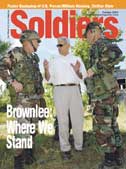DS3 provides advocacy for severely disabled Soldiers, families
By Joe Burlas

|
|
|
WASHINGTON (Army News Service, May 4, 2004) -- Severely disabled Soldiers and their family members have a new way to find answers to service-related questions -- the Disabled Soldier Support System, or DS3 as program officials call it.
Acting Secretary of the Army Les Brownlee and Veterans Affairs Secretary Anthoni J. Principi joined other Army senior leaders in announcing the initiative at a Pentagon media round table April 30.
DS3 is a single information source where severely disabled Soldiers or their family members can go for assistance in getting entitlement or services questions answered. That contact can be via the Army Information Hotline, 1-800-833-6622.
The intent of the program is to provide an additional safety net for severely disabled Soldiers that may have slipped through the cracks in the past after being medically retired, according to Brownlee.
“They have performed enormous service to the nation,” Brownlee said. “With that said, their lives go on, but (those lives are) significantly changed. They may have lost an arm, leg or eye, but they have not lost their courage.”
For purposes of the program, severely disabled means a disability rating, or the likelihood of a rating, of 30 percent or greater, and a special condition. Those conditions include the loss of an eye or limb, a spinal or disfiguring injury, or a psychiatric disorder. The disability rating and special condition do not have to be related to a combat wound or injury.
While Soldiers in the program or their family members can call for assistance at anytime, program officials will contact the disabled Soldiers periodically for at least five years following registration into the program.
“This program is designed to be the advocate for the Soldier and his family,” said Col. Michael Flowers, director of Human Resources Policy Directorate, Army G1, who oversees the DS3 task force.
“This is not a program to do anybody else’s job,” Flowers said. “It’s about assisting to ensure we are doing it right. We take care of our own, even after retirement.”
Doing it right isn’t only ensuring severely disabled Soldiers know what entitlements and services are available to them, according to Lt. Col. Lorelei Coplen, TF DS3 deputy director. It’s also sometimes doing the research and educating different organizations and agencies about what they can do for Soldiers, she said.
“We have had some cases where we called up and said you have the authority to do this and gave them the (Army regulation) paragraph and line number that authorized them to do it,” Coplen said.
While the program has only recently been announced, it has been reaching out and helping qualified Soldiers and their families for several months. Approximately 12,000 Soldiers wounded or injured during Operations Iraqi Freedom and Enduring Freedom; 2,650 of those required medical evacuation and treatment in Germany or the United States. As of Feb. 16, 132 of those Soldiers had been enrolled in the program and have been getting active assistance.
Four Soldiers in the program, two medically retired and two still on active duty, shared their experiences with DS3 at the media round table.
Sgt. James Sides, a flight medic who suffered multiple brain bruises, a broken arm, internal injuries and several minutes under water after his helicopter crashed, credited the program with keeping his family together.
Part of the problem was his wife, Rebecca, having to make a lot of tough decisions alone as Sides was fighting for his life and then recovering from his injuries.
One of those decisions was whether to take Sides off life support when he was in a comma and not expected to survive. Other decisions included how to make the move from their Fort Carson, Colo., home to Wynne, Ark., when Sides was medically retired. Other problems included where to get marriage counseling and counseling help for their two children who were having difficulty accepting their father’s changed life.
“I went thru the (Veterans Affairs) and didn’t get the answers to what I needed,” Sides said. “I found the DSS number, called and got what I needed.”
DS3 made the counseling arrangements Sides and his family, and called back with appointment times.
For Sgt. 1st Class Joseph Briscoe, a special forces Soldier, who lost his right arm below the elbow and nerve damage to his left arm due to wounds in Iraq, DS3 helped him understand how he might be able to stay in the Army, despite his wounds. Currently at Walter Reed Army Medical Center, Washington, D.C., as an outpatient, Briscoe is a 17-year Army veteran.
“I want to see it through to (a normal) retirement,” Briscoe said.
Briscoe said he got briefed on his options of a medical retirement or working to meet the standards for a Medical Fitness Board, which might allow him to stay in the Army, shortly after arriving to Walter Reed while in a drug-induced haze from the pain killer medication he was on.
“Somebody checked the block that I got the briefing,” Briscoe said, “but I really don’t remember what was said.”
When DS3 officials made initial contact with Briscoe, he asked for information on his options and got it.
While the initial focus for the program has been on OIF and OEF Soldiers, it is not limited to Soldiers from recent conflicts, Flowers said. He encourages any Army veteran who believes he or she is qualified for DS3 to call the Army Information Line.
For more information about the initiative, visit the DS3 Homepage, www.ArmyDS3.org.
Additional Photos:


|


